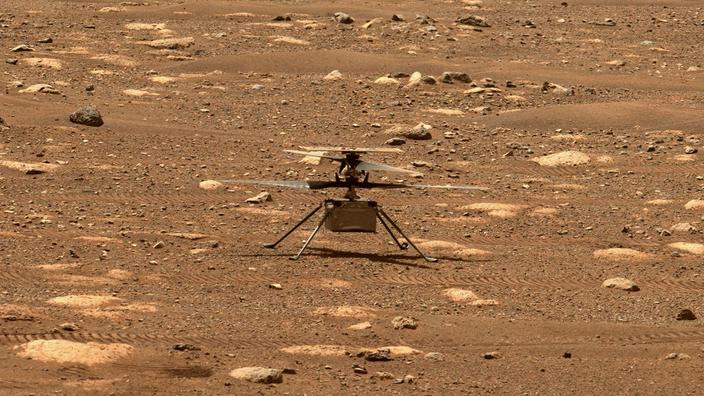NASA's Mars helicopter Ingenuity first spun its propellers in a test, ahead of its scheduled flight overnight Sunday through Monday, the first of a motorized craft to another planet.
"The helicopter is fine, it's healthy,"
Tim Canham, operations manager for Ingenuity, told a press conference on Friday.
Read also: NASA wants to fly a helicopter on Mars in early April
"Last night, (...) we turned the propellers very slowly and carefully,"
he announced.
The moment was captured by the Perseverance rover, several meters away, and on which the helicopter had been carried since it landed on Mars on February 18, before it separated from it last weekend.
NASA has published a very brief video clip of the craft - which looks more like a large drone - with its propellers spinning.
The first flight will take place at 02:54 a.m. GMT on Monday (10:54 p.m. Sunday on the US East Coast), the US space agency said.
The first data is expected to arrive on Earth on Monday around 8:15 a.m. GMT (4:15 a.m. on the US East Coast).
A live broadcast from NASA teams analyzing these first data will be visible on the space agency's website.
The first flight will last 40 seconds in total, and the helicopter will rise only vertically before hovering.
“We're going to take off, go up to three meters high, we're going to pivot in the direction of the rover, take a picture, and then we're going to come back down,”
said Tim Canham.
NASA plans up to five flights, of increasing difficulty, over a period of one month.
A last test of the propellers must still be carried out this Friday, this time
"at full speed,"
said MiMi Aung, project manager for the helicopter at the Jet Propulsion Laboratory (JPL) of NASA.
Soaring in Martian air is a challenge, as it is of a density equivalent to only 1% that of the Earth's atmosphere.
Even if the gravity is less there than on Earth, the NASA teams had to develop an ultra-light machine (1.8 kg), and the propellers will turn much faster than a standard helicopter.
What are the chances of success for this flight?
"The only uncertainty remains the environment of Mars", in
particular
"the winds"
, explained MiMi Aung.
It is a
“high risk” experience
, but with a
“great reward”
if successful, she summarized.

